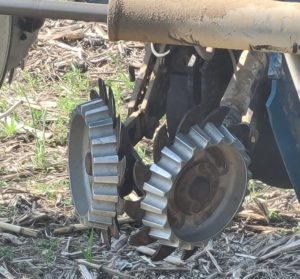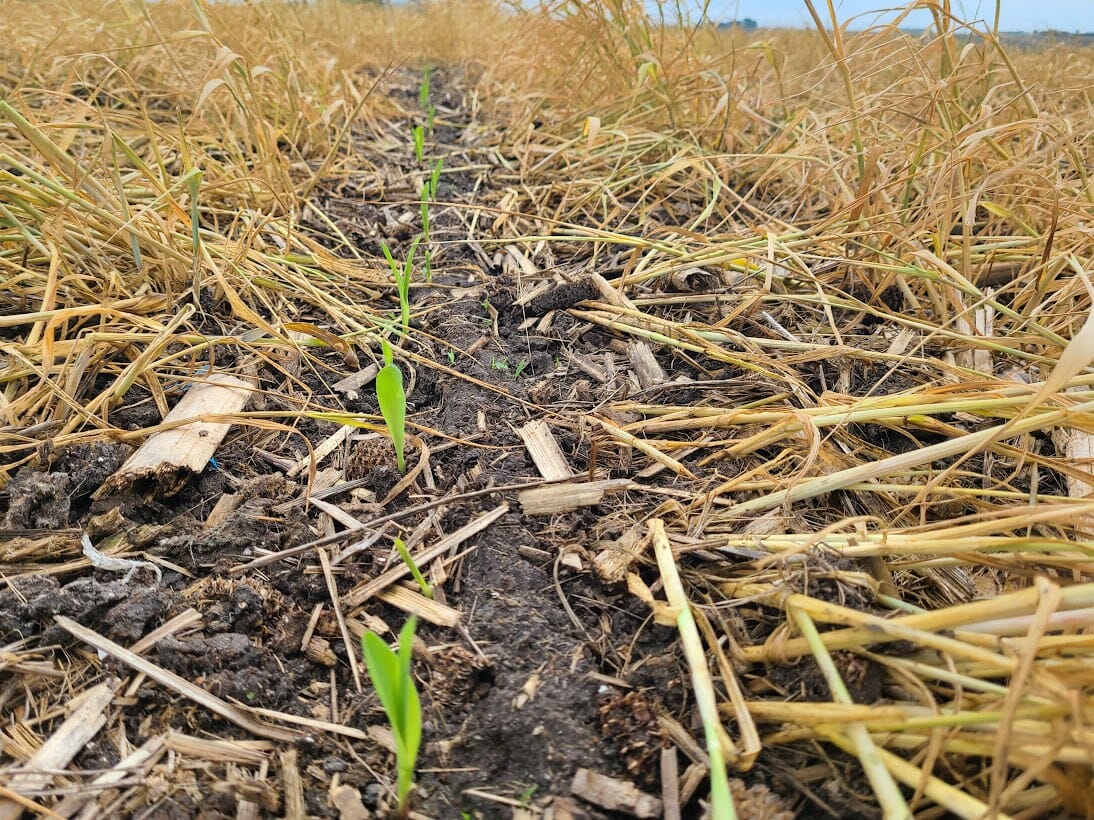Jason Russell’s 4 planting green and planter set-up tips for #plant23

Jason Russell raises hogs, cattle, sheep, corn, soybeans, hay and cover crop seed on his family farm in Monticello, Iowa.
Planting corn and soybeans in living cereal rye leads to better corn and soybean crops for Jason Russell of Monticello, Iowa. What makes the difference? Better-managed soil moisture. Jason reports that keeping the transpiring rye in the field enables him to plant into a ‘goldilocks’ situation – not too wet or too dry. He explains, “When you terminate before planting, you take away your ability to moderate soil water.”
Planting green also makes for smoother planting: the planting units slice through the living cover crop. Alternatively, terminating between a week and two days before planting can cause the dying rye to get rubbery and wrap around the row cleaners. Terminating more than a week before planting usually allows the rye to dry to the point of brittleness- which is also easy to plant into.
Jason has observed that armyworm and cutworm pressure is lower than if he terminates the cover before planting, perhaps because the rye acts as a ‘trap crop’ for pests. The insects feed on the cereal rye instead of the cash crop.

Engaging row cleaners in heavy residue like a no-till corn-on-corn field prepares a residue-free seedbed; however, Jason doesn’t find the row cleaners as necessary when planting soybeans into living cereal rye.
1. Simplify planter set-up
To plant soybeans into a cover, Jason’s planter set-up is simply sharp double disk openers and Yetter Twister closing wheels. For corn, Jason uses Precision Planting CleanSweep to engage SharkTooth row cleaners from the cab, on the go. The row cleaners sit on 1.5-in. wide treader wheels to prevent the row cleaners from going too deep.
2. Check for planting depth
When planting into a dense rye cover, Jason lowers the planter depth settings down a notch. He points out that, cover or not, planting depth is field specific, noting, “It is important to get out of the cab and dig to check depth.” Jason plants corn closer to three inches deep, stating, “the soil temperature is less variable at a deeper depth; less warm-cold-warm-cold. It is easier on the seedling.”
3. For corn, terminate before planting and apply N at planting to avoid N tie-up
Jason has encountered challenges when planting immediately before terminating: the temporarily injured rye – having been run over with the tractor and planter – has reduced capacity for uptake and metabolization of the burndown product. For this reason, Jason chemically terminates rye 4 – 48 hours before planting corn.
To avoid nitrogen tie-up for corn at planting, Jason recommends that anyone with a rye cover before corn moves at least 40 units of nitrogen from their sidedress application to planting time.
N fertilizer application method matters. Jason has observed that simply spraying liquid N at planting onto the rye cover crop can result in the nitrogen product getting tied up in the rye biomass instead of reaching the soil. Instead of broadcast-spraying liquid N, Jason uses a coulter sidedress machine before planting to apply liquid nitrogen (32%) and sulfur (ATS) stabilized with a carbon source, or he applies the same products behind the planter closing wheels on top of the ground next to the row. He adds that using a carbon source like sugar or humates will devolatilize the fertilizer and prevent losses.

Corn emerges from a field that had been planted green. Nitrogen at planting helps bridge any immobilization that occurs as the rye decomposes.
4. Terminate later for soybeans
Jason relay-intercrops a lot of rye with soybeans, but when he terminates the rye as a cover crop, he will often wait until the rye is at pollen-shed to spray, then will roll the rye to create a weed-suppressing mat and to stimulate soybean branching. Later termination helps with mid-season moisture conservation and weed suppression.
Video: Early summer footage from Jason’s soybean fields with late-terminated rye, and the adjacent relay-intercropped rye-soybean strip.
